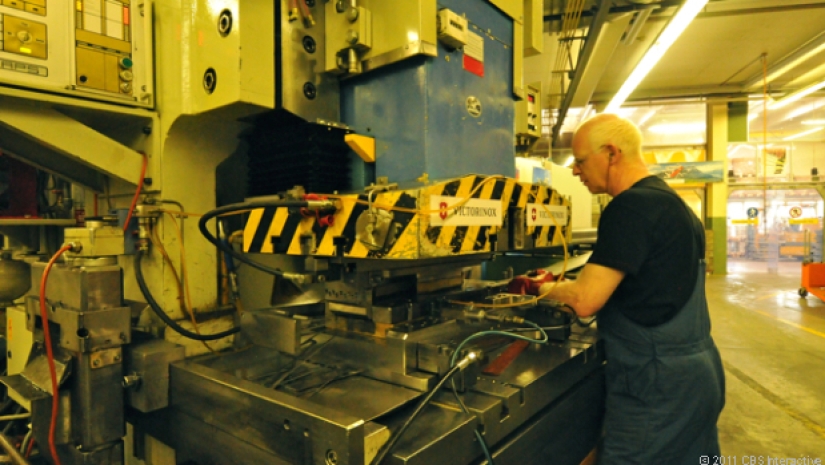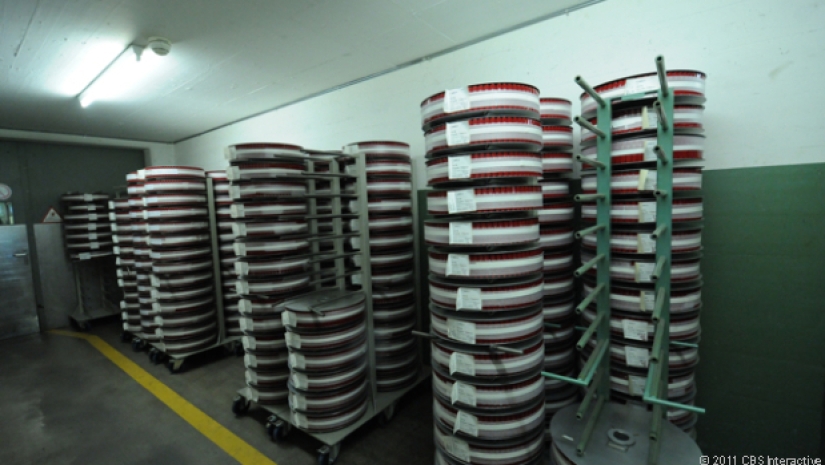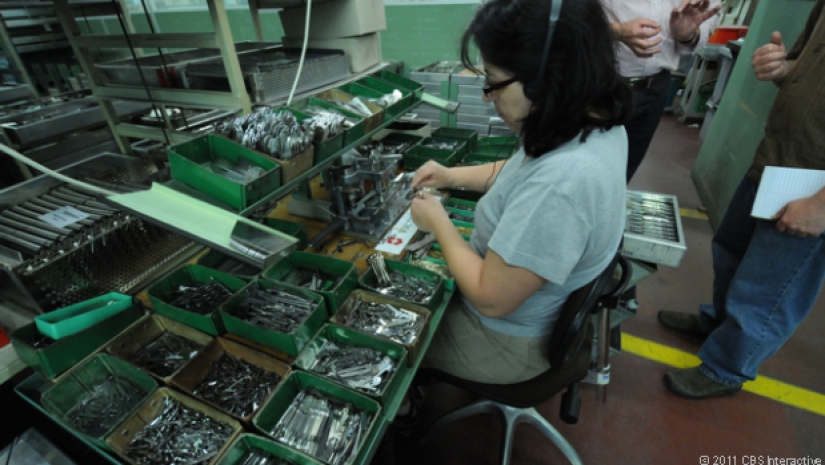You are probably all familiar with the Swiss army knife — a multifunctional folding knife, which is equipped with a blade and several additional tools, such as screwdrivers, openers, corkscrew and so on. In the non-working position, the tools are located inside the knife handle and are released by rotating around the inner hinge.
 Source: LiveJournal/kak-eto-sdelano
Source: LiveJournal/kak-eto-sdelano
Today we will visit the factory, which is located in a small town in central Switzerland, where the company "Victorinox" has been producing world—famous knives since 1891 - even before it became known by this name.

To date, the company produces more than a million knives a year, about 350 different models. The photo shows a container with tweezers, which are a mandatory part in almost every of these models.

This is one of the original models of the Swiss army knife, made back in 1891. It was then that the owner of the company, Karl Elsener, decided to equip the army with Swiss-made knives. Although he did not have a well-known logo at that time, and Elsener's company did not yet bear the name "Victorinox" (which it received a few years later, in honor of Elsener's mother Victoria, and because of the French word "inox", meaning "stainless steel"), there is not the slightest difficulty in this knife to find out the direct predecessor of the one that almost every one of us has today.
The Swiss government still buys knives for all its soldiers from this company. Since 1891, only eight different models have appeared for the Swiss military, the last of which was released in 2008.

At the base of the main blade of this original Swiss army knife, you can see the logo of Karl Elsener's company – before it became known as "Victorinox", it bore the name of its owner.

Elsener wanted to make a special official Swiss army knife for officers, and even started production of a new product. But the Swiss government decided that the officers would still use an ordinary soldier's army knife, which they received when they first joined the army, and decided not to conclude another contract with Elsener. However, the company has been producing officer knives for many years. This is what the 1931 model looked like.

A box of ready-made army knives is waiting to be packed and shipped.

To prevent workers from cutting themselves, taking blades that have just come off the conveyor from the container, a special grip is used.

This machine directs aluminum strips to a stamping machine for the production of delimiters for various tools in a Swiss knife. Delimiters are made of aluminum so as not to add extra weight to the finished knife. The components of the knife themselves are usually made of stainless steel.

Stamping machines that produce more than eight hundred knife parts.

Here you can see the evolution of the Swiss army knife, starting with the original model of 1891 in the lower right corner. In the upper right corner is the newest model, released in 2008.
The previous model, made in 1968, is located in the upper left corner. The 1931 officer's knife is located in the lower left corner. And in the center is one of the latest models with a red handle.

There are dozens of containers with parts for Swiss army knives in the warehouse. There are key rings in this drawer.

A factory worker puts stainless steel sheets into a stamping machine that makes blades.

The blanks of the blades are placed on the conveyor. They will go to the furnace, where they will be exposed to a temperature of 1050 degrees in order to harden stainless steel. This will increase their service life by decades.

After exiting the stamping machine, a special device shakes the container with the blades so that the excess pieces of metal that could remain after stamping fall off.

The surface of the blades coming out of the stamping machine remains rough and rough. Therefore, they are placed in these special machines, which, with the help of artificial ceramic chips and water, polish the blades for a long time, from five to eight hours. After that, the surface of the blade becomes perfectly smooth.

A container with corkscrews.

Plastic toothpicks.

Halves of scissors.

And here are the ready-made scissors. Soon they will be sent to the assembly shop.

Boxes with blades for traditional small Swiss army knives.

Racks with ready-made handles. They can be in several colors, including traditional blue and red.



Next, the handles and blades with a set of tools are placed in a special pressing machine, where the handles are attached to the main part under pressure and as a result, a practically ready knife is obtained, with the exception of tweezers, toothpicks and key rings.

Assembling the knife.



Here we see containers with tweezers and toothpicks. The task of the workers is to quickly attach the parts to the knives coming to them on the conveyor belt.


Blank for the blades of Swiss knives.

Pliers included in the knife.

A box with aluminum clips. They fix the main blade of the knife when it is open.

A container with the main blades of a traditional Swiss army knife.

Not sharpened blades.

In addition to the direct manufacture of Swiss army knives, the company "Victorinox" for a small fee offers another truly invaluable service – repair or replacement of any knife made in the history of the company.
In the photo: this knife, made back in 1931, failed the spring responsible for the action of the main blade.

Due to the popularity of Swiss Victorinox knives, a large number of cheap and low-quality fakes made mainly in China enter the markets.

The worker checks every detail of the Swiss army knife. She uses a cloth to avoid hurting her hands, and a tool to help test each knife and all the parts that make up it.

And this part of the Swiss knife for riders, which is designed for cleaning horses' hooves.

Keywords: Army | Knife | Switzerland
Recent articles

Victor Lustig is considered one of the most skillful and famous scammers in the world. He was arrested about 50 times and released ...

A small apartment is not a sentence! On the contrary, this is an occasion to turn on imagination and come up with ways to stylishly ...
Related articles

Many writers, including Nikolai Gogol in his immortal «Taras Bulba» mentioned that Sich women were not allowed. There is ...

Beautiful decoration of dishes is no less important than its taste. People first "eat" with their eyes, and only then try what is ...

In the Islamic world, men reign supreme and their authority is unshakable. Therefore, the Arab chronicles, which describe the ...

Each of us has heard at least once that "breakfast is the most important meal of the day." Spreading this truth is the work of ...